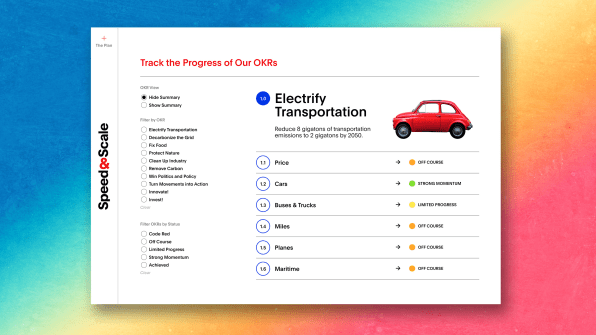- | 9:00 am
This climate action tracker shows exactly where we are on the path to net zero
With so many factors involved, it can be hard to keep track of exactly which indicators are moving in the right direction. A new site collects the data in one place.

Last year, global electric-car sales more than doubled compared to the year before. Solar and wind power are cheaper in most countries than fossil fuels. The world is now spending record amounts on clean energy. New technology is emerging to cut emissions in hard-to-decarbonize industries like steel and cement and aviation. At the same time, hundreds of new coal power plants are under construction, deforestation is surging in the Amazon, and total emissions reached a record high in 2021.
The big picture of climate action can be hard to track as the entire economy transforms. To avoid the worst impacts from climate change, the world will have to reach net zero emissions by 2050, and cut emissions in half in less than eight years. A new tool looks at how the world is doing on those goals.

“The tracker was born to help answer the question, ‘Where are we?’” says Ryan Panchadsaram, advisor to John Doerr, chair of the VC firm Kleiner Perkins. “Can we consolidate all the best data out there into a single place that shows us our progress toward net zero on a global scale?” In 2021, Doerr and Panchadsaram published the book, Speed and Scale, which lays out a plan to reach net zero, with 10 objectives and 55 key results. The new tracker, which the team will keep updating, shows the progress, or lack of, in each area, from climate investment to shipping emissions.

The tool is designed for business and political leaders, says Panchadsaram, who previously served as deputy chief technology officer in the Obama administration. “The idea was to help people see where the biggest sources of emissions can come from, and the measures that they’re really tasked with to move,” he says. “The tracker is designed to encourage targeted actions. We like to say it’s about going for the gigaton. It’s about also leaning on collective might, not always just the individual piece.”![]()
A few of the key results are moving in the right direction, like EV sales, which the team says need to hit a target of 50% of all sales by 2030. “You can actually see this curve looking exponential,” he says. The price of electricity and batteries keeps falling. Still, even the things that are making good progress need more effort to actually be on track. And the majority of items are off track. Many fall into a category the team calls “code red,” from deforestation and beef and dairy consumption to the cost of carbon removal.
The website also includes an action guide with short lists of the most critical steps to take, both at an individual level and within companies, cities, states, and at the national level. “I think when you look at it, you might think wow, this feels obvious,” says Panchadsaram. “This is about my energy usage, how I move, and what I eat. I think that’s part of what we hope comes from this—that the solutions to this climate crisis aren’t as opaque or far out, [and] are actually quite approachable. Rather than the fear of a climate disaster paralyzing us, it’s supposed to galvanize us. We actually can take action, and we can do it today. And let’s just get it done.”






































